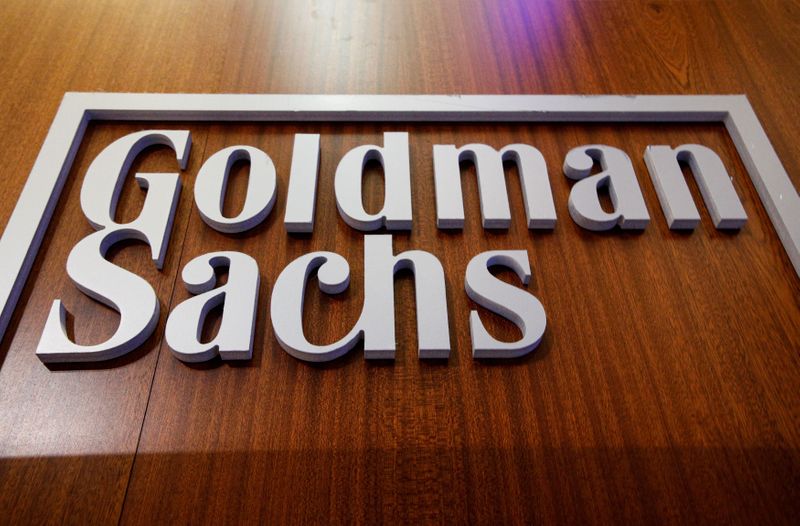By Matt Scuffham
NEW YORK (Reuters) -Goldman Sachs Group Inc plans to issue new profitability targets for the next three years, consistent with longer-term goals it set in 2020, thanks in part to the investment banking and trading boom during the pandemic, three sources at the bank told Reuters.
At its last investor day in January 2020, Goldman set three- and five-year targets for return-on-equity (RoE) and return-on-tangible-equity (RoTE), two measures of profitability, that analysts at the time said were ambitious.
Goldman has since benefited from the U.S. Federal Reserve’s stimulus measures pumping liquidity into capital markets, while the subsequent boom in the Wall Street firm’s main businesses has meant progress has been faster than anticipated, the three sources said.Still, the sources said executives understand that the favorable environment is likely to recede as the central bank tightens monetary policy. The bank is considering issuing a new set of profitability targets for the period through 2025 that would be in line with longer-term targets it set in 2020.
Specifically, the sources said the bank is planning to set new medium term return-on-equity (RoE) and return-on-tangible-equity (RoTE) targets of at least 15%. They cautioned that decisions relating to targets could still change between now and next year.
Asked for comment on the expected target, a spokesman for Goldman said: “At our Investor Day in January 2020, we disclosed a medium-term ROE target of 13 percent and longer-term ROE target of mid-teens.” The spokesman declined further comment.
The 2020 targets formed an important part of Chief Executive David Solomon’s plan to rejuvenate the bank, which had struggled to adapt to tougher regulations introduced after the 2007-09 financial crisis, which crimped profit margins at its core trading businesses. Since then, progress has been faster than anticipated across most of Goldman’s businesses, sources said.
Growing Goldman’s fledgling consumer business, Marcus, has proved more challenging. Earlier this year, management backed away from an earlier goal to turn Marcus profitable in 2021, saying it would take at least another year to turn a profit.
Goldman had only achieved an RoE of 10% and RoTE of 10.6% in 2019. Despite that, the bank is tracking well ahead of the mid-term goals so far this year. In the first nine months of 2021, it achieved an annualized RoE of 25.7% and an annualized RoTE of 27.2%. In 2020, the bank achieved a return on equity of 11.1% and return on tangible equity of 11.8%.
Return on equity is a key metric used globally to assess banks’ profitability. It tells investors how much profit banks generate from each dollar invested by shareholders. Return on tangible equity excludes intangible assets such as goodwill.
FASTER GROWTH
Goldman will update on the key targets early next year but is not planning on hosting a formal investor day where executives give extended briefings on different parts of the business, as it did in January 2020, one of the sources said.
Goldman last updated on progress against its targets in January this year when it maintained goals for efficiency and return-on-equity. In October it reported a surge in profits boosted by a wave of M&A activity and initial public offerings.
Goldman has benefited from a massive injection of liquidity into financial markets by the Fed since last March, because it makes a higher proportion of its revenues from investment banking and trading.
Its trading businesses have enjoyed their most successful period since the 2007-2009 financial crisis while its investment banking division has reaped rewards from record global deal making.
COST SAVINGS
Executives are also discussing whether to increase a target to achieve $1.3 billion in cost savings over the three years to end 2022, the three sources said. Chief Operating Officer John Waldron said at a conference in June that the bank had identified a further $400 million of potential savings.
The savings are an important factor behind improving the bank’s RoE and remain a top priority, one of the sources said. However, executives have yet to decide whether they want to set a new headline cost savings target, the three sources said.
Cost cutting measures have also helped the bank’s performance, along with Solomon’s client services initiative, One Goldman Sachs (NYSE:GS), which formed a key part of his vision after he became CEO in late 2018, the sources said.
By improving collaboration, Goldman hoped to gain more business from existing clients and improve its market share in a number of areas, those sources said. The strategy has enabled it to do more business with its biggest corporate clients and to serve more clients overall, the sources said.
The bank’s shares have risen by 47% in the year to date, outperforming the sector, reflecting increased confidence among analysts and investors in Solomon’s ability to deliver on his transformation plan.
Executives acknowledge current rates of return are unsustainable longer-term because they are driven largely by the unusually strong operating environment, the three sources said. However, they are confident the bank will continue to outperform the existing mid-term targets even when conditions normalize. Executives expect the bank will continue to benefit from cost savings and market share gains, the three sources said.
“They’ve delivered a tremendous performance throughout 2021,” said Devin Ryan, analyst at JMP Securities, part of Citizens Financial (NYSE:CFG) Group. “They’re gaining market share in sales & trading and investment banking, and they’re executing well on these new initiatives.”
Goldman shares, part of the Dow Jones Industrial Average, were up 3.2% at $388.59 in late trading.

